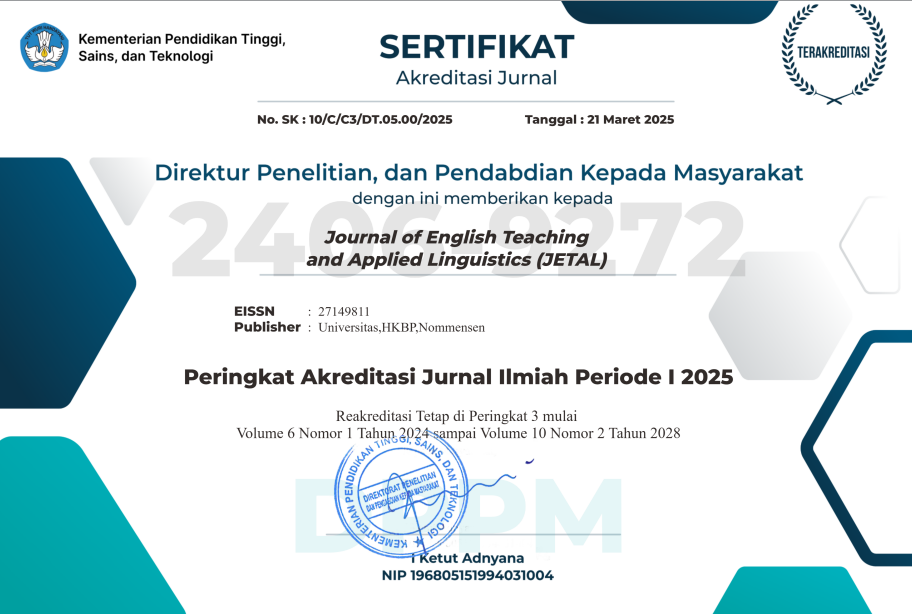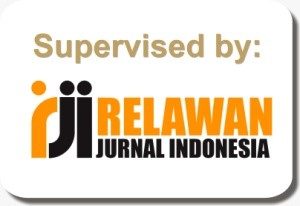Behind the Mask: A Psychological Exploration of Emily Nelson’s Sociopathic Traits in A Simple Favor Movie
Abstract
This study aims to showcase the personality disorder of a single character in “A Simple Favor” movie. Applying a qualitative method, the researchers employ a descriptive qualitative method to examine the characteristic type of the main character’s sociopathic personality disorder. The findings reveal that the main character named Emily Nelson exhibits a complicated sociopathic personality disorder defined by three interconnected dimensions: narcissistic, amoral, and aggressive characteristics traits of a sociopath. Emily's narcissism is shown by her arrogance, entitlement, and deceptive behavior. Her amoral behavior indicates a serious absence of guilt for her detrimental deeds. The latter sociopathic characteristic she displays is aggressiveness. Emily’s aggression is purely utilitarian and expressive. The study highlights the utility of psychological frameworks in analyzing fictional characters, enriching literary and film criticism by providing deeper insight into character motivation and complexity. The recommendation include analyzing a broader range of characters across different films or literary works to identify common patterns and unique features in the depiction of sociopathy. Besides that, comparative studies would enhance understanding of how antisocial personality disorder is represented in popular culture. The study exclusively analyzes the character Emily Nelson from “A Simple Favor” movie, focusing on her sociopathic traits as depicted in a fictional narrative. This limits the generalizability of findings to real-life cases of sociopathy or antisocial personality disorder, as film characters are constructed for dramatic effect and may not fully align with clinical realities
References
Disorders, Fifth Edition. Washington, DC: American Psychiatric Publishing
Creswell, J., & Guetterman, T. (2018). Educational Research: Planning, Conducting, and Evaluating Quantitative and Qualitative Research, 6th Edition.
Creswell, J.W. and Poth, C.N. (2018). Qualitative Inquiry and Research Design Choosing among Five Approaches. 4th Edition, SAGE Publications, Inc., Thousand Oaks.
Frederick Rotgers, P. D. A., & Michael Maniacci, P. D. (2005). Antisocial Personality Disorder: A Practitioner’s Guide to Comparative Treatments. Springer Publishing Company. https://books.google.co.id/books?id=Tna-9d_ykPIC
Goodwin, J., Saab, M., Dillon, C., Kilty, C., McCarthy, A., O’Brien, M., & Philpott, L. (2021). The use of film-based interventions in adolescent mental health education: A systematic review. Journal of Psychiatric Research, 137. https://doi.org/10.1016/j.jpsychires.2021.02.055
Hanifah, Tara (2019). Women’s Language Features Used by Stephanie and Emily in A Simple Favor Movie. Unpublished Thesis. Jakarta: Universitas Darma Persada.
Hare, R. D., & Neumann, C. S. (2008). Psychopathy as a Clinical and Empirical Construct. Annual Review of Clinical Psychology, 4(Volume 4, 2008), 217–246. https://doi.org/https://doi.org/10.1146/annurev.clinpsy.3.022806.091452
Holmes, S. E., Slaughter, J. R., & Kashani, J. (2001). Risk Factors in Childhood That Lead to the Development of Conduct Disorder and Antisocial Personality Disorder. Child Psychiatry and Human Development, 31(3), 183–193. https://doi.org/10.1023/A:1026425304480
Millon, T., Grossman, S., Millon, C., Meagher, S., & Ramnath, R. (n.d.). Personality Disorders in Modern Life.
Millon, T & Davis R, (2000), ‘The Antisocial Personality’, in Personality Disorder in Modern Life, John Wiley & Sons Inc., New York, p.102-36
Persson, P. (2003). Understanding Cinema A Psychological Theory of Moving Imagery. Understanding Cinema: A Psychological Theory of Moving Imagery. https://doi.org/10.1017/CBO9780511497735
Rainsford, D. (2014). Studying literature in English: An introduction. https://doi.org/10.4324/9780203483824
Suhendar, S. (2018). An Analysis on Antisocial Personality Disorder of Kevin In “We Need To Talk About Kevin Movie Directed” By Lynne Ramsay. JELL (Journal of English Language and Literature) STIBA-IEC Jakarta, 3(01). https://doi.org/10.37110/jell.v3i01.45
Taylor, S.J., Bogdan, R. and DeVault, M. (2015). Introduction to Qualitative Research Methods: A Guidebook and Resource. 4th Edition, John Wiley & Sons, London, UK.
Veronika, I., Azi, R., & Sofian, I. (2017). Antisocial Personality Disorder of the Main Character in The Bad Seed Movie. JOURNAL, 2(1).
Widiger, T. A., & Mullins-Sweatt, S. N. (2009). Five-Factor Model of Personality Disorder: A Proposal for DSM-V. Annual Review of Clinical Psychology, 5(Volume 5, 2009), 197–220. https://doi.org/https://doi.org/10.1146/annurev.clinpsy.032408.153542

This work is licensed under a Creative Commons Attribution-ShareAlike 4.0 International License.
Authors retain copyright and grant the journal right of first publication with the work simultaneously licensed under a Creative Commons Attribution-ShareAlike 4.0 International License (CC BY-SA 4.0) that allows others to share the work with an acknowledgment of the work's authorship and initial publication in this journal.
Authors are able to enter into separate, additional contractual arrangements for the non-exclusive distribution of the journal's published version of the work (e.g., post it to an institutional repository or publish it in a book), with an acknowledgment of its initial publication in this journal.
Authors are permitted and encouraged to post their work online (e.g., in institutional repositories or on their website) prior to and during the submission process, as it can lead to productive exchanges, as well as earlier and greater citation of published work (See The Effect of Open Access).






